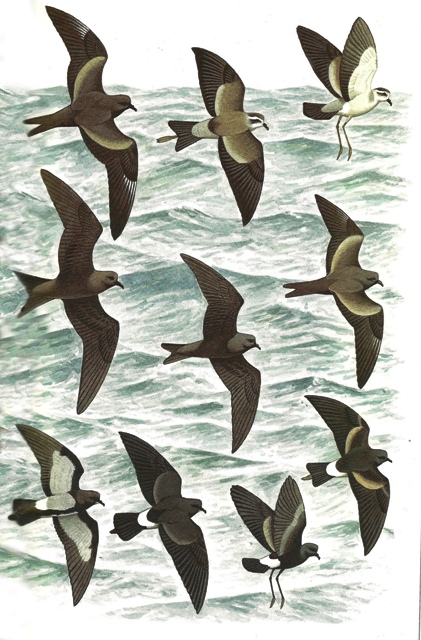Major site for mysterious seabirds discovered off Denis Island |15 December 2014
• Potential for a new form of ecotourism
From Hawaii and New Zealand in the Pacific to countries bordering the North Atlantic, excursions to see ocean-going (pelagic) seabirds are a growing pastime enjoyed by many adventurous birdwatchers. But nowhere in the Indian Ocean has the possibility for this form of ecotourism been explored. World pelagic seabird authority Hadoram Shirihai recently visited Seychelles and I was fortunate enough to team up with him to explore the little known waters of the Seychelles Bank north of Denis Island.
Hadoram has been at the forefront of research in this field, developing a “chumming” operation using frozen blocks of oily fish material to attract seabirds.
In this way he has made many new discoveries including six new species or species thought to be extinct. I run Seychelles Bird Records Committee which authenticates reports of all bird species in Seychelles, including these little known pelagic species. We teamed up together to carry out the first ever chumming operation in Seychelles waters off Denis Island on the edge of the Seychelles Bank to try to learn more about the poorly known pelagic birds of our region.Our target was mainly to find storm-petrels, secretive birds that spend their lives on oceans far out of sight of land returning to wild remote islands only to breed. The results were truly amazing.
It is inevitable that such mysterious birds should be shrouded in myth and legend. In the early days of European exploration, sailors saw these small delicate birds fluttering over mighty waves as incongruous to the hostility of the open ocean. They treated them with both reverence and suspicion.
The conviction grew that storm-petrels were the damned souls of drowned sailors and their appearance was said to foretell a storm. Alternative names reflect these superstitions such as Mother Carey’s Chicken (a corruption of mater cara, the Virgin Mary), seawitch and in Creole, satanik. The name petrel, first recorded in 1602, is a corruption of pitteral, referring to the bird's pitter-pattering across the water, a habit which also accounts for another alternative name, Jesus Bird.
How do you find a small elusive bird on a huge ocean and one that generally avoids contact? Hadoram takes the approach that if we cannot come to the birds, then make the birds come to us by using chum. He sent the magic formula in advance to Denis Island and Bird Island, the best bases to use to search for petrels close to the Seychelles Bank. Unfortunately Bird Island was unable to assist, but Denis Island responded positively and created the requisite blocks of chum to a very high standard. It worked like a charm pulling in storm petrels seemingly from nowhere. In just two days we recorded 25 Wilson’s Storm-petrels and a Black-bellied Storm-petrel, both of which breed close to Antarctica and have rarely been seen in Seychelles. But perhaps most interesting was the discovery of thirteen Matsudaira’s Storm-petrels.
Matsudaira’s Storm-petrel breeds on remote inaccessible islands off southern Japan and is classified by BirdLife as Vulnerable because of their restricted range. After the breeding season, it is thought to move south across the equator, to the Timor Sea off Australia, and then west into the Indian Ocean, but its wintering grounds are largely unknown. It has been speculated that it may be in the tropical belt from Seychelles to East Africa but there have been very few reliable reports and Seychelles Bird Records Committee have recorded just one single bird seen between Providence and Farquhar in 1995. 
We used chum at five different sites off Denis Island, travelling over 220 nautical miles in total to reach them. At one site no birds turned up in our allotted time but at the other four we identified 13 Matsudaira’s Storm-petrels. At these same sites we also found no fewer than 25 Wilson’s Storm-petrels (recorded in Seychelles six times previously) and one Black-bellied Storm-petrel (recorded twice previously), both of these species breed on subantarctic islands.
The number of birds seen in such a short space of time suggests the Seychelles Bank could be a major location for Matsudaira’s Storm-petrels, which are difficult to find anywhere else in the world. There is the potential to develop this as a new source of tourism and there are many birders around the world who are taking to this relatively new form of ecotourism. Pelagic seabirders will travel a long way to see such enigmatic species as Matsudaira’s Storm-petrel and while we need to learn a lot more, Seychelles might be in the top one or two locations worldwide to see them.
Our sincere thanks go to the management and staff of Denis Island who did everything possible to make this expedition a success. Special thanks go to the boat team of Zorro and Rolly for their patience and enthusiasm. Despite being used to game-fishing enthusiasts making more conventional requests, not crazy birdwatchers floating frozen fish miles offshore in the hope of seeing goodness knows what, they contributed a great deal to make this expedition a success..
There is now the potential for Seychelles to develop a new kind of tourism: pelagic seabird trips, a popular pastime in countries including USA, Australia, UK, Germany, Netherlands and South Africa. We are scratching the surface and need to learn more about the locations and seasonality of our mysterious visitors. But we have made a start on Denis Island. As Seychelles reaches capacity for hotels, perhaps it is time to explore the untapped ecotourism potential of the rich oceans around our islands that make up over 99.9% of the Seychelles EEZ (exclusive economic zone).
Adrian Skerrett




